key FIAT TIPO 5DOORS STATION WAGON 2020 Owner handbook (in English)
[x] Cancel search | Manufacturer: FIAT, Model Year: 2020, Model line: TIPO 5DOORS STATION WAGON, Model: FIAT TIPO 5DOORS STATION WAGON 2020Pages: 304, PDF Size: 9.12 MB
Page 54 of 304

DISPLAY
DESCRIPTION
The vehicle is equipped with a display
that can show useful information to the
driver while driving.
With the ignition device in STOP
position and ignition key removed, the
display lights up and shows the time
and total odometer reading (in km or
miles) for a few seconds when a door is
opened/closed.
GEAR SHIFT INDICATOR
The Gear Shift Indicator (GSI) system
gives an indication (2 fig. 77 for versions
with multifunction display or 4 fig. 78 for
versions with reconfigurable
multifunction display) on the instrument
panel display to advise the driver when
to change gear.
Through the GSI, the driver is informed
that shifting gear will allow a reduction
in fuel consumption.
When the
symbol appears on the
display, the GSI suggests switching to a
higher gear, while when the
symbol
is displayed, the GSI suggests
changing to a lower gear.The indication in the display remains
until a gear is shifted or the driving
conditions go back to a situation where
gearshifting is not required to improve
consumption.
On some versions, the engaged gear
and the recommended one are
displayed next to the
orsymbol.
Icons
ormay appear when
the GSI recommends shifting to a gear
two steps higher than the currently
engaged one. On these versions, the
system only displays the engaged gear
when the driving conditions do not
make it necessary to change gear to
optimise fuel consumption.
The indications of the engaged gear
and the recommended gear shift
temporarily disappear from the display
during a gear shift and reappear as
soon as the gear shift is finished.
MULTIFUNCTION
DISPLAY
The display fig. 77 will show the
following information:
1: Headlight alignment position (only
with dipped beam headlights on)
2: Gear Shift Indicator (GSI)
3: Engaged gear indication
4: Time
5: Outside temperature (for
versions/markets, where provided)
6: Odometer (display of distance
travelled in kilometres/miles)
7: Display of "Cruise Control" or
instantaneous speed (for
versions/markets, where provided)
7705036J0001EM
52
KNOWING THE INSTRUMENT PANEL
Page 108 of 304
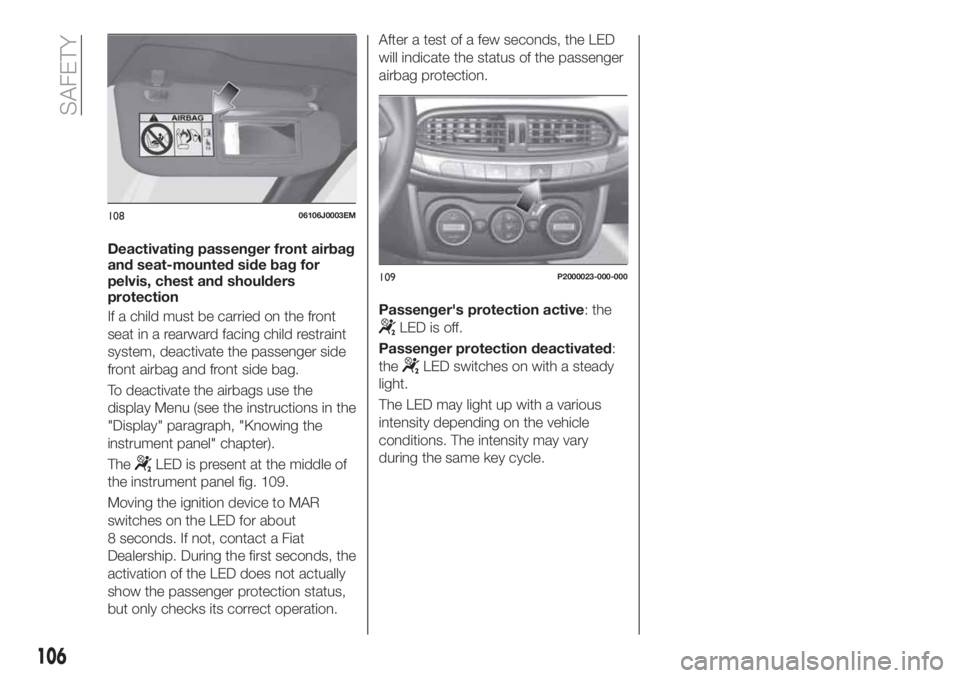
Deactivating passenger front airbag
and seat-mounted side bag for
pelvis, chest and shoulders
protection
If a child must be carried on the front
seat in a rearward facing child restraint
system, deactivate the passenger side
front airbag and front side bag.
To deactivate the airbags use the
display Menu (see the instructions in the
"Display" paragraph, "Knowing the
instrument panel" chapter).
The
LED is present at the middle of
the instrument panel fig. 109.
Moving the ignition device to MAR
switches on the LED for about
8 seconds. If not, contact a Fiat
Dealership. During the first seconds, the
activation of the LED does not actually
show the passenger protection status,
but only checks its correct operation.After a test of a few seconds, the LED
will indicate the status of the passenger
airbag protection.
Passenger's protection active: the
LED is off.
Passenger protection deactivated:
the
LED switches on with a steady
light.
The LED may light up with a various
intensity depending on the vehicle
conditions. The intensity may vary
during the same key cycle.
10806106J0003EM
109P2000023-000-000
106
SAFETY
Page 114 of 304
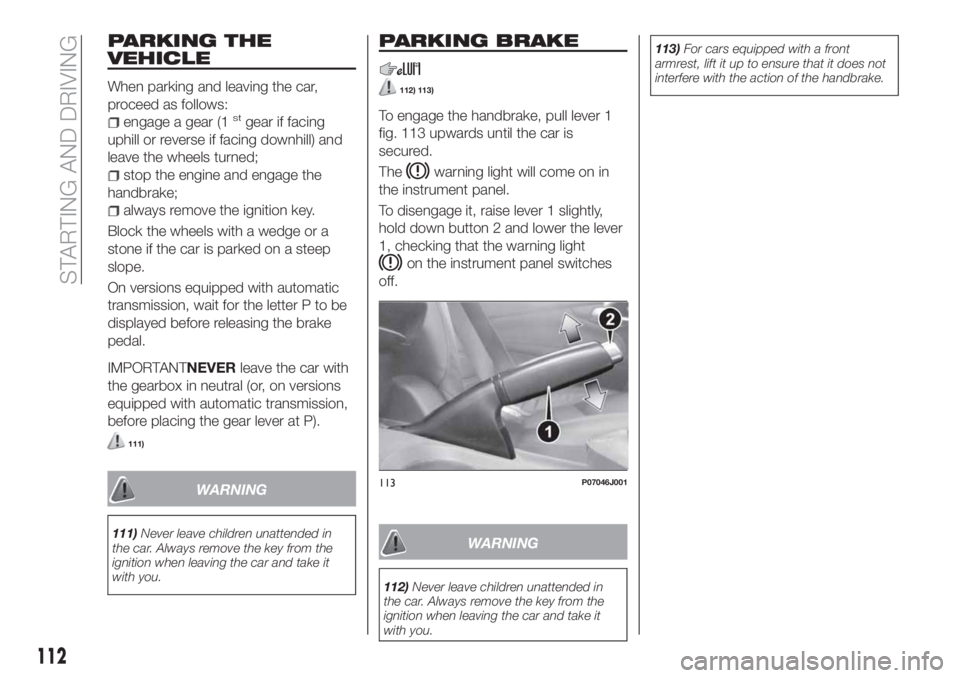
PARKING THE
VEHICLE
When parking and leaving the car,
proceed as follows:
engage a gear (1stgear if facing
uphill or reverse if facing downhill) and
leave the wheels turned;
stop the engine and engage the
handbrake;
always remove the ignition key.
Block the wheels with a wedge or a
stone if the car is parked on a steep
slope.
On versions equipped with automatic
transmission, wait for the letter P to be
displayed before releasing the brake
pedal.
IMPORTANTNEVERleave the car with
the gearbox in neutral (or, on versions
equipped with automatic transmission,
before placing the gear lever at P).
111)
WARNING
111)Never leave children unattended in
the car. Always remove the key from the
ignition when leaving the car and take it
with you.
PARKING BRAKE
112) 113)
To engage the handbrake, pull lever 1
fig. 113 upwards until the car is
secured.
The
warning light will come on in
the instrument panel.
To disengage it, raise lever 1 slightly,
hold down button 2 and lower the lever
1, checking that the warning light
on the instrument panel switches
off.
WARNING
112)Never leave children unattended in
the car. Always remove the key from the
ignition when leaving the car and take it
with you.113)For cars equipped with a front
armrest, lift it up to ensure that it does not
interfere with the action of the handbrake.
113P07046J001
112
STARTING AND DRIVING
Page 118 of 304
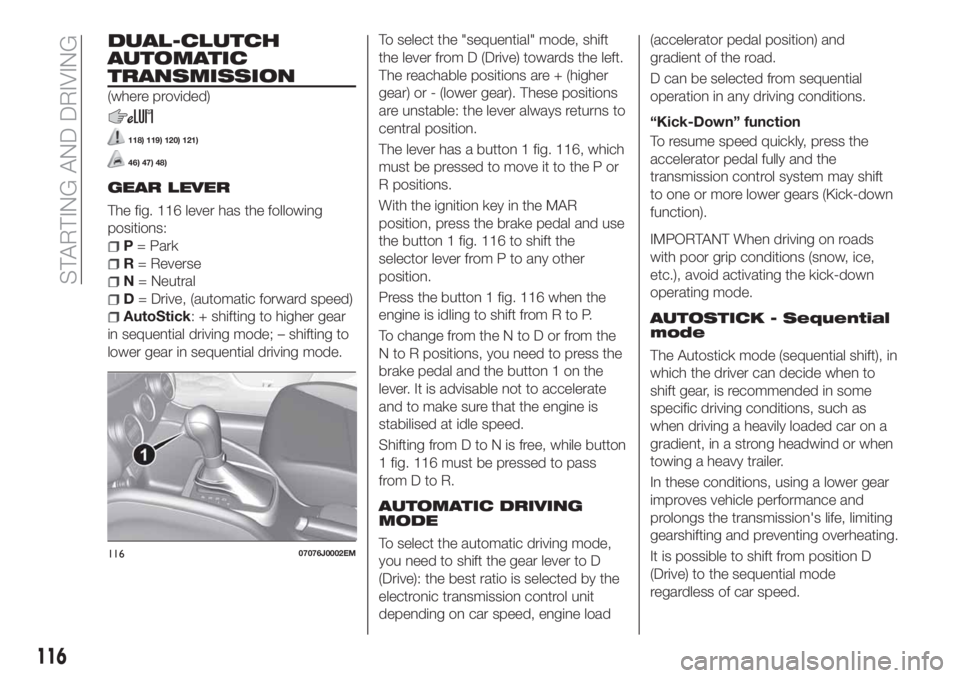
DUAL-CLUTCH
AUTOMATIC
TRANSMISSION
(where provided)
118) 119) 120) 121)
46) 47) 48)
GEAR LEVER
The fig. 116 lever has the following
positions:
P= Park
R= Reverse
N= Neutral
D= Drive, (automatic forward speed)
AutoStick: + shifting to higher gear
in sequential driving mode; – shifting to
lower gear in sequential driving mode.To select the "sequential" mode, shift
the lever from D (Drive) towards the left.
The reachable positions are + (higher
gear) or - (lower gear). These positions
are unstable: the lever always returns to
central position.
The lever has a button 1 fig. 116, which
must be pressed to move it to the P or
R positions.
With the ignition key in the MAR
position, press the brake pedal and use
the button 1 fig. 116 to shift the
selector lever from P to any other
position.
Press the button 1 fig. 116 when the
engine is idling to shift from R to P.
To change from the N to D or from the
N to R positions, you need to press the
brake pedal and the button 1 on the
lever. It is advisable not to accelerate
and to make sure that the engine is
stabilised at idle speed.
Shifting from D to N is free, while button
1 fig. 116 must be pressed to pass
fromDtoR.
AUTOMATIC DRIVING
MODE
To select the automatic driving mode,
you need to shift the gear lever to D
(Drive): the best ratio is selected by the
electronic transmission control unit
depending on car speed, engine load(accelerator pedal position) and
gradient of the road.
D can be selected from sequential
operation in any driving conditions.
“Kick-Down” function
To resume speed quickly, press the
accelerator pedal fully and the
transmission control system may shift
to one or more lower gears (Kick-down
function).
IMPORTANT When driving on roads
with poor grip conditions (snow, ice,
etc.), avoid activating the kick-down
operating mode.
AUTOSTICK - Sequential
mode
The Autostick mode (sequential shift), in
which the driver can decide when to
shift gear, is recommended in some
specific driving conditions, such as
when driving a heavily loaded car on a
gradient, in a strong headwind or when
towing a heavy trailer.
In these conditions, using a lower gear
improves vehicle performance and
prolongs the transmission's life, limiting
gearshifting and preventing overheating.
It is possible to shift from position D
(Drive) to the sequential mode
regardless of car speed.
11607076J0002EM
116
STARTING AND DRIVING
Page 119 of 304
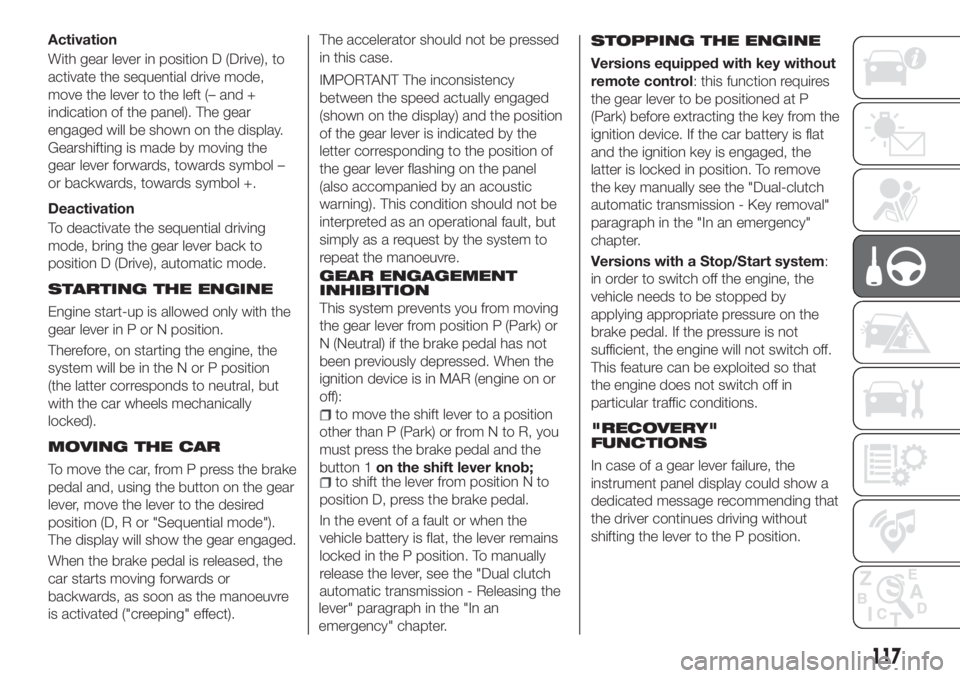
Activation
With gear lever in position D (Drive), to
activate the sequential drive mode,
move the lever to the left (– and +
indication of the panel). The gear
engaged will be shown on the display.
Gearshifting is made by moving the
gear lever forwards, towards symbol –
or backwards, towards symbol +.
Deactivation
To deactivate the sequential driving
mode, bring the gear lever back to
position D (Drive), automatic mode.
STARTING THE ENGINE
Engine start-up is allowed only with the
gear lever in P or N position.
Therefore, on starting the engine, the
system will be in the N or P position
(the latter corresponds to neutral, but
with the car wheels mechanically
locked).
MOVING THE CAR
To move the car, from P press the brake
pedal and, using the button on the gear
lever, move the lever to the desired
position (D, R or "Sequential mode").
The display will show the gear engaged.
When the brake pedal is released, the
car starts moving forwards or
backwards, as soon as the manoeuvre
is activated ("creeping" effect).The accelerator should not be pressed
in this case.
IMPORTANT The inconsistency
between the speed actually engaged
(shown on the display) and the position
of the gear lever is indicated by the
letter corresponding to the position of
the gear lever flashing on the panel
(also accompanied by an acoustic
warning). This condition should not be
interpreted as an operational fault, but
simply as a request by the system to
repeat the manoeuvre.
GEAR ENGAGEMENT
INHIBITION
This system prevents you from moving
the gear lever from position P (Park) or
N (Neutral) if the brake pedal has not
been previously depressed. When the
ignition device is in MAR (engine on or
off):
to move the shift lever to a position
other than P (Park) or from N to R, you
must press the brake pedal and the
button 1on the shift lever knob;
to shift the lever from position N to
position D, press the brake pedal.
In the event of a fault or when the
vehicle battery is flat, the lever remains
locked in the P position. To manually
release the lever, see the "Dual clutch
automatic transmission - Releasing the
lever" paragraph in the "In an
emergency" chapter.
STOPPING THE ENGINE
Versions equipped with key without
remote control: this function requires
the gear lever to be positioned at P
(Park) before extracting the key from the
ignition device. If the car battery is flat
and the ignition key is engaged, the
latter is locked in position. To remove
the key manually see the "Dual-clutch
automatic transmission - Key removal"
paragraph in the "In an emergency"
chapter.
Versions with a Stop/Start system:
in order to switch off the engine, the
vehicle needs to be stopped by
applying appropriate pressure on the
brake pedal. If the pressure is not
sufficient, the engine will not switch off.
This feature can be exploited so that
the engine does not switch off in
particular traffic conditions.
"RECOVERY"
FUNCTIONS
In case of a gear lever failure, the
instrument panel display could show a
dedicated message recommending that
the driver continues driving without
shifting the lever to the P position.
117
Page 120 of 304

In this case, the transmission will
maintain the forward gear (with reduced
performance) even if the lever is shifted
to R or N. Once the lever is in the P
position, or after turning off the car, it
will not be possible to select R nor any
forward gear. In this case, contact a Fiat
Dealership.
WARNING
118)Never use position P (Park) instead of
the parking brake. Always engage the
parking brake when parking the car to
avoid the accidental movement of the car.
119)If the P (Park) position is not engaged,
the car could move and injure people.
Before leaving the car, make sure that the
gear lever is in position P and that the
parking brake is engaged.
120)Do not shift the gear lever to N
(Neutral) and do not stop the engine when
driving on a downhill road. This type of
driving is dangerous and reduces the
possibility of intervening in the case of
variation of the road traffic or surface. You
risk losing control of your car and causing
accidents.
121)Never leave children unattended in
the car. Always remove the ignition key
when leaving the car and take the key with
you.
IMPORTANT
46)Before moving the gear lever from
position P (Park), bring the ignition device
to position MAR and press the brake pedal.
Otherwise, the gear lever may get
damaged.
47)If the car is on a slope, always engage
the parking brake BEFORE moving the shift
lever to the P position.
48)Only engage reverse gear with the car
stationary, the engine idling and the
accelerator pedal fully released.
STOP/START
SYSTEM
(where provided)
The Start&Stop system automatically
stops the engine each time the car is
stationary and starts it again when the
driver wants to move off.
In this way, the vehicle efficiency is
increased, by reducing consumption,
dangerous gas emissions and sound
pollution.
Start&Stop mode will be active
whenever the engine is started.
OPERATING MODE
Stopping the engine
Versions with manual transmission
With the vehicle stopped, the engine
stops with gearbox in neutral and clutch
pedal released.
Versions with automatic
transmission
With car at a standstill and brake pedal
pressed, the engine switches off if the
gear lever is in a position other than R.
The system does not operate when the
gear lever is in R, for making parking
manoeuvres easier. In the event of
stops uphill, engine switching off is
disabled to make the "Hill Hold Control"
118
STARTING AND DRIVING
function available (works only with the
engine running).
Page 143 of 304

the maximum level because if the
UREA freezes the system can be
damaged. Follow the instructions in
the “Topping up
AdBlue®
diesel
emissions additive (UREA)” paragraph
in this chapter.
If the UREA is spilled on painted
surfaces or aluminium, immediately
clean the area with water and use
absorbent material to collect the
fluid that has been spilled on the
ground.
Do not try to start the engine if
UREA was accidentally added to
the Diesel fuel tank, this can result
in serious engine damage, contact
a Fiat Dealership.
Do not add additives or other
fluids to
AdBlue®
, doing so could
damage the system.
The use of non-conforming or
degraded
AdBlue®
may lead to
indications appearing on the instrument
panel display (see “Warning lights and
messages" paragraph in the “Knowing
the instrument panel” chapter).
Never pourAdBlue®
into another
container: it could be contaminated.
If theAdBlue®
runs out, see
“Warning lights and messages"
paragraph in the “Knowing the
instrument panel” chapter to continue
using the car normally.
AdBlue®
(UREA) storage
AdBlue®
(UREA) is considered a very
stable product with a long shelf life.
Stored at temperatures LOWER than
32°C, it has a shelf life of at least one
year.
Follow the instructions on the label of
the container.
Fuel storage - Diesel Fuel
139)
In case of the storage of massive
amounts of fuel, good maintenance is
essential. The fuel contaminated with
water favours the proliferation of
"microbes". These microbes create a
"slime" that can clog the filter system
and fuel pipes. Remove water from the
supply tank and regularly replace the
filter pipe.
NOTE When a Diesel engine runs out
of fuel, air is blown through the fuel
system.
Emergency refuelling
If there is no fuel in the car or the supply
circuit is completely empty, proceed as
follows to reintroduce fuel to the tank:
open the boot and take adaptor 3
fig. 133, located in the tool box or in the
Fix&Go kit container (according to the
versions);
open flap 1 fig. 131, as described
previously;
introduce the adaptor in the filler as
shown and refuel;
after refuelling, remove the adapter
and close the flap;
finally refit the adaptor in the boot.
Versions with LPG system
The gas filler is located next to the
petrol filler cap. It has a "non return",
located in the filler body itself.
To access the filler 2 fig. 134 open the
access flap 1.
Observe the following precautions
during the refuelling operation:
switch off the engine;
apply the handbrake;
ignition key turned to the OFF
position;
do not smoke;
hand the special adapter over to the
qualified LPG refuelling personnel.
13307206J0002EM
141
Page 155 of 304
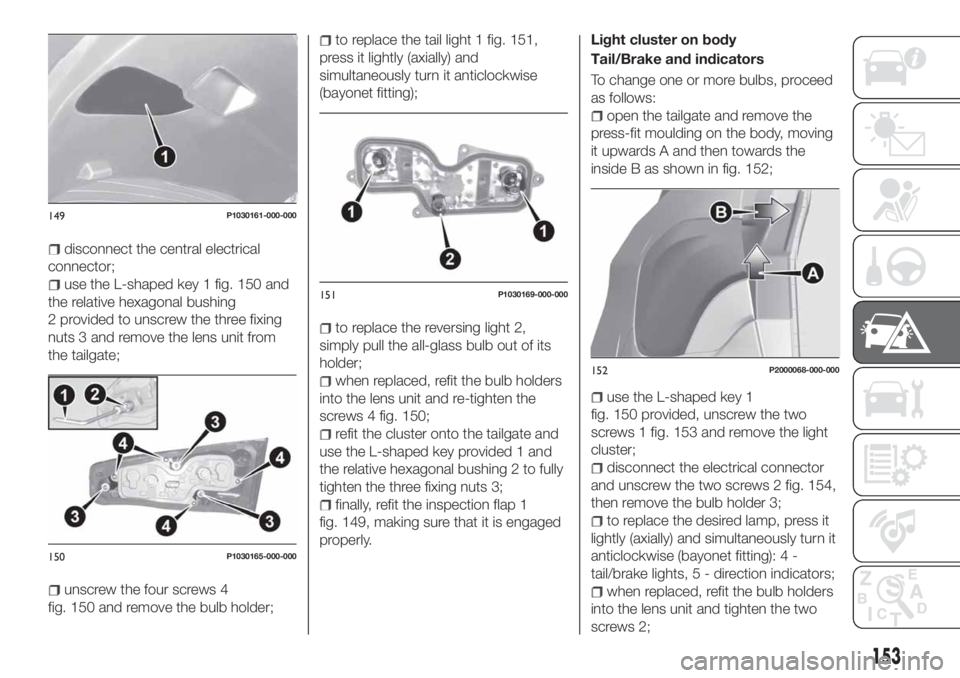
disconnect the central electrical
connector;
use the L-shaped key 1 fig. 150 and
the relative hexagonal bushing
2 provided to unscrew the three fixing
nuts 3 and remove the lens unit from
the tailgate;
unscrew the four screws 4
fig. 150 and remove the bulb holder;
to replace the tail light 1 fig. 151,
press it lightly (axially) and
simultaneously turn it anticlockwise
(bayonet fitting);
to replace the reversing light 2,
simply pull the all-glass bulb out of its
holder;
when replaced, refit the bulb holders
into the lens unit and re-tighten the
screws 4 fig. 150;
refit the cluster onto the tailgate and
use the L-shaped key provided 1 and
the relative hexagonal bushing 2 to fully
tighten the three fixing nuts 3;
finally, refit the inspection flap 1
fig. 149, making sure that it is engaged
properly.Light cluster on body
Tail/Brake and indicators
To change one or more bulbs, proceed
as follows:
open the tailgate and remove the
press-fit moulding on the body, moving
it upwards A and then towards the
inside B as shown in fig. 152;
use the L-shaped key 1
fig. 150 provided, unscrew the two
screws 1 fig. 153 and remove the light
cluster;
disconnect the electrical connector
and unscrew the two screws 2 fig. 154,
then remove the bulb holder 3;
to replace the desired lamp, press it
lightly (axially) and simultaneously turn it
anticlockwise (bayonet fitting): 4 -
tail/brake lights, 5 - direction indicators;
when replaced, refit the bulb holders
into the lens unit and tighten the two
screws 2;
149P1030161-000-000
150P1030165-000-000
151P1030169-000-000
152P2000068-000-000
153
Page 156 of 304
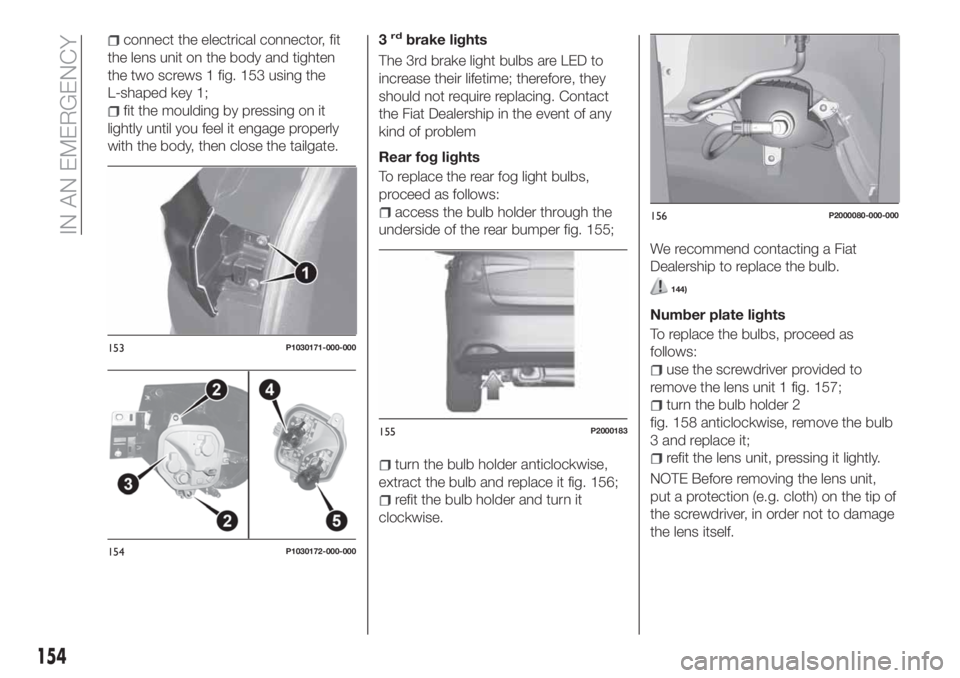
connect the electrical connector, fit
the lens unit on the body and tighten
the two screws 1 fig. 153 using the
L-shaped key 1;
fit the moulding by pressing on it
lightly until you feel it engage properly
with the body, then close the tailgate.3
rdbrake lights
The 3rd brake light bulbs are LED to
increase their lifetime; therefore, they
should not require replacing. Contact
the Fiat Dealership in the event of any
kind of problem
Rear fog lights
To replace the rear fog light bulbs,
proceed as follows:
access the bulb holder through the
underside of the rear bumper fig. 155;
turn the bulb holder anticlockwise,
extract the bulb and replace it fig. 156;
refit the bulb holder and turn it
clockwise.We recommend contacting a Fiat
Dealership to replace the bulb.
144)
Number plate lights
To replace the bulbs, proceed as
follows:
use the screwdriver provided to
remove the lens unit 1 fig. 157;
turn the bulb holder 2
fig. 158 anticlockwise, remove the bulb
3 and replace it;
refit the lens unit, pressing it lightly.
NOTE Before removing the lens unit,
put a protection (e.g. cloth) on the tip of
the screwdriver, in order not to damage
the lens itself.
153P1030171-000-000
154P1030172-000-000
155P2000183
156P2000080-000-000
154
IN AN EMERGENCY
Page 163 of 304
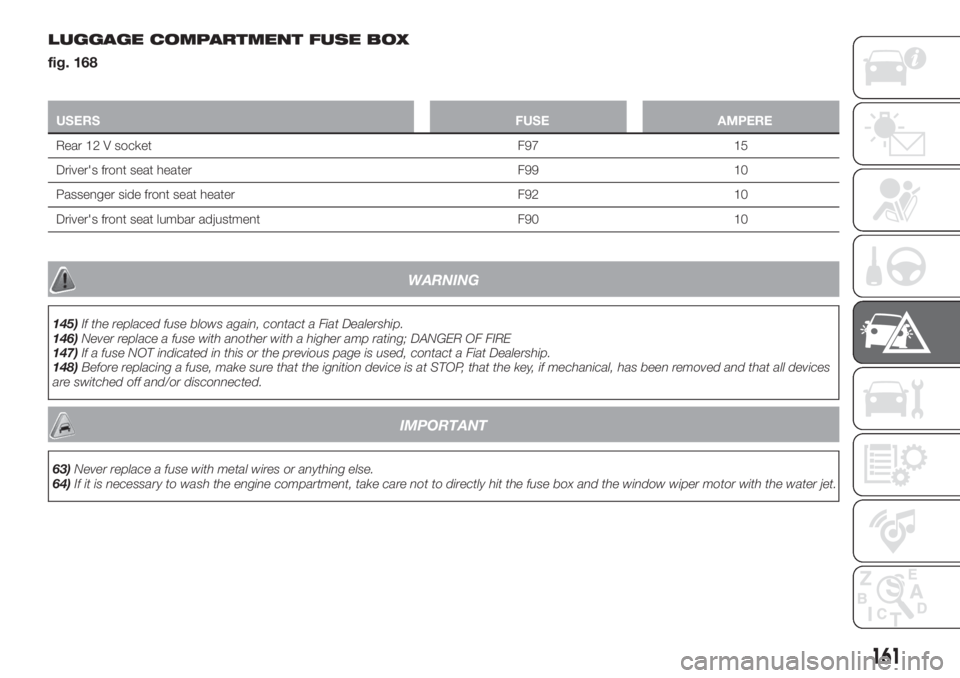
LUGGAGE COMPARTMENT FUSE BOX
fig. 168
USERSFUSE AMPERE
Rear 12 V socket F97 15
Driver's front seat heater F99 10
Passenger side front seat heater F92 10
Driver's front seat lumbar adjustment F90 10
WARNING
145)If the replaced fuse blows again, contact a Fiat Dealership.
146)Never replace a fuse with another with a higher amp rating; DANGER OF FIRE
147)If a fuse NOT indicated in this or the previous page is used, contact a Fiat Dealership.
148)Before replacing a fuse, make sure that the ignition device is at STOP, that the key, if mechanical, has been removed and that all devices
are switched off and/or disconnected.
IMPORTANT
63)Never replace a fuse with metal wires or anything else.
64)If it is necessary to wash the engine compartment, take care not to directly hit the fuse box and the window wiper motor with the water jet.
161